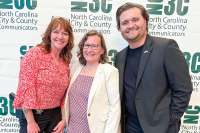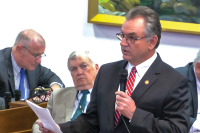A Celtic slice of France
One of this year’s Folkmoot groups, Bleuniadur, hails from northern France in the region known as Brittany. SMN’s Michael Beadle conducted an email interview with Fabrice David, executive director of the all-volunteer Breton folk music and dance group.
Where in France are you located?
Saint-Pol-de-Leon is on the seaside in the Northwest of Brittany. Brittany is a peninsula in the West of France. Our county is called “Finistère” or in Breton “Penn ar Bed,” which means “land’s end.” It is often said that it is the last place in Europe before the USA. Brittany is a Celtic region like Scotland, Wales or Ireland. We have the same Celtic background with a Celtic language — Breton — very close to Welsh.
Tell me a little history about your group.
Bleuniadur formed in 1977 in Saint-Pol-de-Léon. In 1984, the group developed by creating a dancing school. We began to take part in international festivals in 1996. Bleuniadur has three groups: one of children, one of youngsters and the “elite” group, the one that will come to Waynesville. We will be 30 with 25 dancers, 3 musicians, the artistic director and a technician. The group is mostly young with an average of 22 year old.
What are some of the professions of the dancers and musicians?
Related Items
There are mostly students. I am a teacher in Breton language and folk culture. Some other professions: a secretary, a farmer, a tiler, a designer of theatre stages, a fireman.
How did you get the name “Bleuniadur?”
Bleuniadur means “blossom” in the Breton language. The word exactly describes the dynamic movement of the flower when it opens. The word was chosen by the founders when they heard it in the mouth of a Breton-speaking farmer.
How often does your group get together to rehearse?
We rehearse every Saturday night (8-11 p.m.) and one Sunday every month (9 a.m.-5 p.m.).
What are the challenges you face as a folk dance group?
The main challenge is to keep the folk dance and music alive with their particularities. We work hard on researching, teaching and creation. The group tries at the same time to have strong and deep roots and to be modern.
What are some of the group’s dances that we might expect to see at Folkmoot?
Suite dances of the Penze Valley
This dance is a very old dance from Northern Brittany. In this part of Brittany, the power of the clergy was so strong that it was forbidden to dance. The only dance that was authorized was a dance in two lines, one of men and one of women — without any physical contact. In a few villages, the people in line wouldn’t touch each other and connected thanks to a handkerchief. The priest oversaw the dance. After the people had danced, they had to go to mass to be forgiven for the pleasure they had had during the dance.
Suite of dances from Plélauff
In the small “fisel” region in the centre of Brittany, the “gavotte” dance had a specific evolution because of the dance contests that were held at night, after work in the fields, between the young men and young women of this region. The judges put candles inside the circle of dancers and laid on the ground to see if the step was well done. The winner was the man who could dance the correct step for the longest time. It was very hard because the dance is in three parts and could last a half hour. Each family developed its own style and defended it. The best male dancer was awarded tobacco, and the best female won a handkerchief or chocolate. Generally the winner would marry in the coming months because winning meant that the young man was very strong and would be able to feed his family.
What kinds of musical instruments will you bring?
We play a mix of traditional instruments (accordion, drums, flute, pipe) and modern ones (guitar and keyboard). We have two instruments that are unique to Brittany: the binioù and the bombard. The bombard is a folk oboe and the binioù is a high-pitching bagpipe. They must be played together. The sound is very particular — very high and very loud. It is made to be played outside and to be heard by everyone. In the 19th century, the two musicians sat on barrels so that all the dancers could hear them, especially for weddings where there were usually about 1,000 guests.
What do you hope to do and see at Folkmoot?
We are looking forward to discovering North Carolina. But the most important thing for us in a festival is to share a moment with the people there and to meet them: the organizers, the Waynesville people, the other groups and the audience. We enjoy sharing our culture and discovering other people’s culture. Sometimes, meeting people can have unexpected results: two years ago we were in Italy and a dancer from Bleuniadur met a girl from a group from Panama. They are married now and had a baby last Sunday.
What would you like people in America to know about your culture, your songs and dances?
Those who saw the French group “Empi et Riaume” [at Folkmoot] last year will be surprised. We are completely different because Breton culture is specific, very far from French culture. Our Celtic roots are present in every aspect of our culture: music, dance, costumes, traditions. We feel much closer to the Irish and the Scots than the French, even if we are French citizens.
It is going to be a very exciting experience for us to go to Folkmoot. It is the result of several years of work to take part in a famous U.S. festival.
It is also very exciting because of the connections between Brittany and America. Brittany is a land of great sailors and many of them took part in the foundation of the U.S. and Canada. Moreover, in the mid-20th century, thousands of Bretons left Brittany in order to work in the U.S. If you want to know more about the group, please visit our Web sites: www.bleuniadur.com and bleuniadur.over-blog.com.









